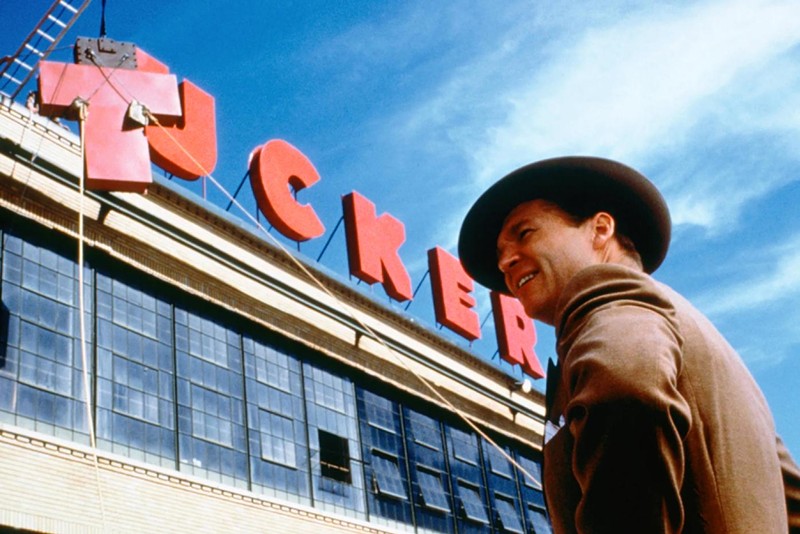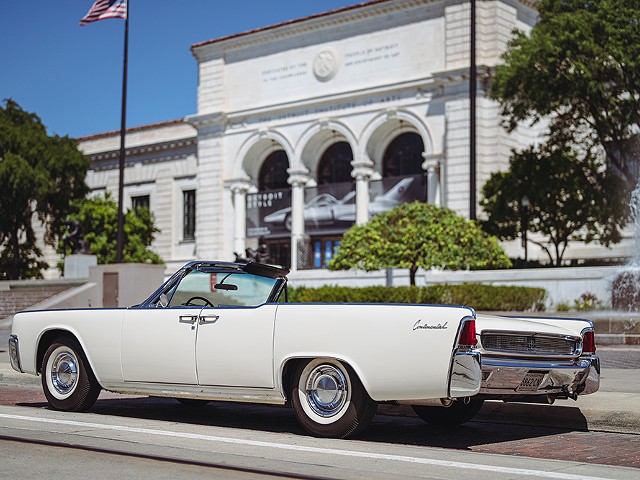
Sly, big-hearted Tucker: The Man and His Dream brings a self-reflexive but inviting style to what might have been a dry did-you-know biopic: one getting a revival screening at the Detroit Film Theatre this weekend. A longtime passion project for Francis Ford Coppola (initially intended to be a hybrid musical, it still jangles pleasantly), Tucker hinges on Jeff Bridges’s embodiment of Preston Tucker, a dauntless underdog eager to buck the longstanding Detroit automakers’ vice grip on the industry by launching his own brand. While the film’s sometimes rote script and its buoyant, emotionally expressive formal features seem at times to chafe against one another, the latter enable it to succeed anyway, culminating in a work of inimitable style.
Set in the 1950s after Tucker designed vehicles and munitions for the American war effort, Coppola’s direction pitches the man as stubbornly and a bit naively ambitious: something Bridges plays off by imbuing him with his almost cartoonishly boyish charms. It’s no great surprise Coppola related to the Ypsilanti husband and father of four, a self-starter with an appetite for risk and an agreeable sense of entitlement regarding wealthy financiers’ support. I won’t be the first to note the parallels with the the director’s own life and his films One from the Heart and Apocalypse Now — movies that saw Coppola dig grave financial holes for himself driven by some wild stew of ego, integrity, and creative ambition, crossing his fingers that it would all come out all right in the end.
Here, the stakes and budget are lower than Coppola’s early banner productions, the air looser and more playful. The cast – which features Frederic Forrest (also of One and Apocalypse) as a key car designer, Joan Allen as Tucker’s sharp but practical wife Vera, and Dean Stockwell in an indelible cameo role — all seem keen to run with what they’re handed, eschewing realism for a brisk but heightened affect most all of them seem to share. (At times I was reminded of the Wachowski Sisters’ live-action Speed Racer). Realism has little to do with Coppola’s aims here, nor does aesthetic fidelity to the cinematic period in which Tucker’s set. Benefitting from the guiding hand of inimitable cinematographer Vittorio Storaro (perhaps most notably of 1970’s The Conformist, a key influence on Coppola’s The Godfather), Tucker’s crew deploys a grab-bag of film-historical techniques. Bright-blue day-for-night scenes radiate into dining rooms festooned with eye-popping wallpaper; numerous high-stakes phone calls are shot not in split screen but with dazzling, reality-bending split diopter techniques. These and many more technical flourishes result not in distraction but elation, enlivening the film with a sense of creative ambition that seems to flow out from its lead.
While the film’s technical aspects feel quite fresh, the story beats prove less so. Though the screenplay-level bones of the project are made to feel defamiliarized through stylistic expression (or adornment), the portions in which such skeletons make themselves visible provide Tucker with its most distracting aspect. Seemingly offhand dialogue scenes designed to cue up essential flashes of innovation (Eureka moments, let’s say) feel received from handbooks in their conceptualization, especially since such instances in biopics still stand now as a tested Hollywood standby. But the problem is less the artificiality in the writing — considering the heightened register of the whole endeavor — but instead the lack of invention. The very thing that gives so much of Tucker its refreshing sense of vigor and zest is absent in these moments in a way that’s revealing in a negative, inexpressive sort of sense. In moments such as these, the gears moving the film’s narrative can be glimpsed, and they look mundane when sighted. It’s almost enough to make you second-guess the sense of verve that feels so present — and nearly dazzling — throughout the rest of the film.
But Hollywood movies are comprised of their scripts, performances, and visual styles all at once, and the harmonies that ring the loudest in any are bound to change from moment to moment. For most of Tucker, the pieces of its style that come together with the most force seem largely able to make up for its script’s adherence to convention. (A case could even be made that the script’s plain normalcy enables the film’s flexible style by easing the pressures of providing visual and editorial forms of continuity.) For Coppola, there seems to be — as in his too-overlooked One From the Heart — an earnest but comparatively brighter sense of hope guiding things along here. When Tucker pitches his car — with its swiveling headlights, its first-of-its-kind safety features, and even its colorway and silhouette — Coppola and company seem genuinely mystified, taking to the film’s showmanship even as they’re the ones putting the whole thing on. The sensation proves uplifting, making me happy to partake in what they’re having as a viewer — even despite the film’s sparse faults.
If there’s anything disingenuous about the film’s sense of belief in creative fulfillment as its own reward, I couldn’t find much evidence for it. On the contrary, Tucker seems to capture what it preaches thoroughly if not perfectly, allowing for a welcome sense of immersion in a quite contagious mood.
Tucker: The Man and His Dream screens at the DIA’s Detroit Film Theatre at 7 p.m. on Friday, Sept. 16, 2 p.m. and 7 p.m. on Saturday, Sept. 17, and 4 p.m. on Sunday, Sept. 18; 5200 Woodward Ave., Detroit; 313-833-7900; dia.org. Tickets are $9.50 for general admission.
Stay connected with Detroit Metro Times. Subscribe to our newsletters, and follow us on Google News, Apple News, Twitter, Facebook, Instagram, Reddit, or TikTok.





